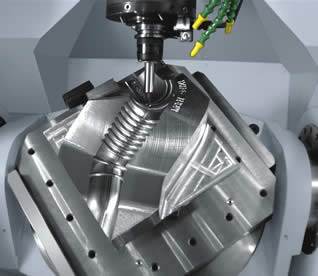Combining Ultrasonic and Conventional Machining Operations
Ultrasonic technology machines hard, brittle materials accurately and easily.
Ultrasonic machining is an easy-to-use technology that allows a mold manufacturer to machine very hard or brittle materials with flexibility and accuracy. Ultrasonic machining centers can perform both conventional and ultrasonic machining operations. By combining these technologies in one machine, the user has the capability to machine across the entire material spectrum.
Ultrasonic Basics and Benefits
In ultrasonic machining, an electrical HF-signal is transmitted via induction through a small air gap from a stationary coil located on the spindle to a rotating coil located on the HSK toolholder. The high frequency supplied to the piezo elements of the actuating toolholder generates a corresponding vibration on the tip of the tool between 20 to 50 kHz. The vibration of the tool is combined with a simultaneous rotation up to 42,000 rpm.
The vibration of an undefined diamond tool causes a significant reduction in process forces resulting in higher material removal rates and less tool wear than conventional methods. Conventional methods would be considered grinding or EDM.
Another benefit to using ultrasonic machining is the resulting excellent surface quality. A finish of Ra<0.2 micron can be achieved, depending on the material. Also, there is enhanced flushing of the machined particles located in the cutting zone due to the ultrasonic motion of the tool in combination with the inner coolant supply.
In the old method of ultrasonic machining, the entire spindle vibrated and energy was transferred via slip rings. This method had the disadvantage that the spindle had a reduced lifetime, which limited its widespread use in industry. Current state-of-the-art technology involves transferring the energy across an air gap where there are no touching components. Therefore, isolating the vibration to strictly the tool allows for seamless toolchanging capabilities in the automatic toolchanger from a conventional to an ultrasonic toolholder.
The ultrasonic parameters are also provided within a software program. With an ADC (adaptive control)/ACC (acoustic control), there is automatic feed adjustment during the machining process. And, process variables are the spindle torque (for ADC) and the generator output power (for ACC). This results in a controlled machining environment with reduced process forces at the tool and constant cutting speeds.
With an UGC (ultrasonic generator control), the user can either manually input the ultrasonic parameters—such as frequency range, amplitude and output power—or this can be automatically found using smart software provided with the machine.
Moldmaking Applications
For moldmakers, ultrasonic machining can be useful when considering materials that have typically not been machined in the past. One such material is carbide. Usually carbide is machined using an EDM process. Ultrasonic machining—on the other hand—can machine carbide directly in one set-up with minimal tool wear and eliminates the need to produce electrodes.
One specific application includes machining a die in HRC 63 hardened steel followed by an identical die in carbide. The hardened steel die, which was 32mm in diameter and 16mm deep, was efficiently machined using geometrically-defined cutting tools and high-speed cutting processes by taking advantage of the 42,000-rpm spindle and high accelerations and feedrates generated by the all axis linear motors on an ultrasonic machining center. The complete machining time was 12 minutes.
Another job includes an identical die in carbide. With a quick tool change from a conventional HSK 32 toolholder to a HSK 32 ultrasonic toolholder, the user was able to begin work on the carbide die, which had dimensions of 32mm in diameter and 16mm deep. In one set-up the carbide die was completely machined using undefined diamond tools from Schott (www.schott-diamantwerkzeuge.com). The total machining time took approximately three hours.
For those looking to add machining equipment to the shop floor, consider an ultrasonic machine. It gives the user flexibility and the ability to machine any material a customer may throw at you.
Related Content
How to Eliminate Chatter
Here are techniques commonly used to combat chatter and guidelines to establish a foundation for optimizing the moldmaking process.
Read MoreThe Benefits of Hand Scraping
Accuracy and flatness are two benefits of hand scraping that help improve machine loop stiffness, workpiece surface finish and component geometry.
Read MoreMaintaining a Wire EDM Machine
To achieve the ultimate capability and level of productivity from your wire EDM on a consistent, repeatable and reliable basis, regular maintenance is a required task.
Read MoreSurface Finish: Understanding Mold Surface Lingo
The correlation between the units of measure used to define mold surfaces is a commonly raised question. This article will lay these units of measure side by side in a conversion format so that companies can confidently understand with what they are dealing.
Read MoreRead Next
Improve Shop Competitiveness With Five-Axis Capability
The key to keeping work local, while still remaining profitable, is a willingness to evaluate and dramatically alter your shop’s processes by investing in new technology.
Read MoreReasons to Use Fiber Lasers for Mold Cleaning
Fiber lasers offer a simplicity, speed, control and portability, minimizing mold cleaning risks.
Read MoreHow to Use Continuing Education to Remain Competitive in Moldmaking
Continued training helps moldmakers make tooling decisions and properly use the latest cutting tool to efficiently machine high-quality molds.
Read More

























